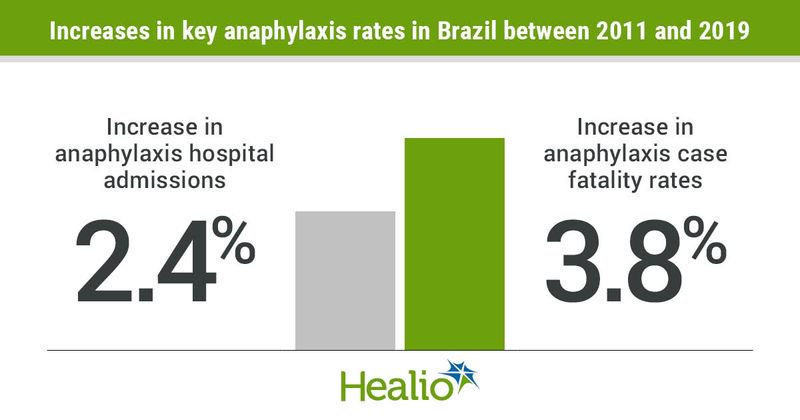Hospital admissions, fatalities due to anaphylaxis increasing in Brazil
Although rates of anaphylaxis appear to be increasing with no rise in fatalities elsewhere in the world, rates of fatalities due to anaphylaxis are increasing in Brazil, according to a study published in Clinical and Experimental Allergy.
These data could support public health policy to improve emergency care for people with anaphylaxis, Luciana Kase Tanno, MD, PhD, head of the Montpellier WHO Collaborating Center in Montpellier, France, and colleagues wrote in the study.

“These findings may influence officials in Brazil to facilitate wider availability of epinephrine devices such as EpiPens and other measures to protect people at risk of anaphylaxis,” Tanno said in a press release.
The researchers examined data reported to the Brazilian Hospital Information System from 2011 to 2019 involving 5,716 admissions due to anaphylaxis for all causes, for an average hospitalization rate of 0.71 per 100,000 population per year, or 0.26% of overall hospital admissions.
Hospitals classified 52% of cases as unspecified, 31.4% as iatrogenic, 8.4% as food-related and 8.1% as insect-related. Also, a quarter of cases involved iatrogenic anaphylaxis among children aged younger than 5 years.
Total cases of anaphylaxis significantly increased by a mean trend of 2.4% per year (range, 1.9%-2.9%; P < .0001).
Specifically, there was no significant change in rates of anaphylaxis related to food (mean trend, 0.05% per year; range, –3% to 3.2%).
However, iatrogenic cases and cases due to drugs increased by a mean trend of 1.6% per year (range, 0.2%-3.3%; P = .046). Insect cases increased by 5.05% per year (range, 1.75%-8.46%; P = .024). Unspecified cases increased by a mean trend of 2.88% (range, 1.6%-4.18%; P < .0001).
Females (52.8%) were more frequently admitted to the hospital for anaphylaxis compared with males, except for cases related to insect sting, which the researchers attributed to differences in exposure.
Most admissions were among adults aged 30 to 59 years (36.3%), although the researchers noted that 13.8% of admissions were among children aged 4 years and younger. Also, more young children were admitted for food-related anaphylaxis, whereas more adults were admitted for iatrogenic anaphylaxis and anaphylaxis related to medications.
The researchers found 334 cases (5.8%) that had fatal outcomes, with fatality rates ranging from 4.9% to 7.5% during the study period. Fatality rates increased by a mean trend of 3.8% per year (range, 2.1%-6.1%; P = .037).
Unspecified cases were the leading category for fatalities (59%), with no significant change over the study period (case fatality ratio = 1.02; 95% CI, 0.97-1.07). Iatrogenic cases accounted for 26% of cases, increasing over time (case fatality ratio = 1.09; 95% CI, 1.02-1.18). Insect cases were next at 8%, with an increase over time (case fatality ratio = 1.2; 95% CI, 1.04-1.38), followed by food cases at 6%, with no change (case fatality ratio = 0.91; 95% CI, 0.79-1.07).
With 44% of deaths occurring among patients aged older than 60 years, the researchers found a significant association between increased age and risk for fatal anaphylaxis, with a mean trend of a 2.5% increase per 10 years (range, 2%-2.9%; P < .0001).
Although they do not believe that this epidemiological data alone are enough to influence public policy, the researchers said their findings could be a starting point for discussions with regulators and governmental bodies.
For example, the researchers continued, adrenaline autoinjectors are only available via import in Brazil. This limited availability may contribute to the increase in out-of-hospital death rates among patients with high risk for anaphylaxis, according to the researchers.
With increasing anaphylaxis admissions and case fatality rates in Brazil, the researchers said, national strategies could improve emergency care for people with anaphylaxis.
Reference:
Study reveals increasing rates of anaphylaxis-related hospital admissions and deaths in Brazil. https://newsroom.wiley.com/press-releases/press-release-details/2022/Study-reveals-increasing-rates-of-anaphylaxis-related-hospital-admissions-and-deaths-in-Brazil/default.aspx. Published: July 21, 2022. Accessed: July 22, 2022.
